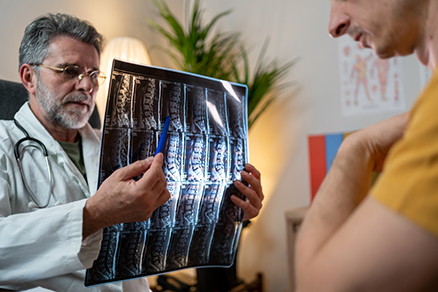Spinal cord injuries may be among the most traumatic injuries a body can suffer. They damage any part of the spinal cord, a long, tube-like structure that goes from the brainstem at the base of the skull to the lower back. The spinal cord is made of nerve tissue protected by the spine (vertebral column) and cushioned by spinal fluid. Spinal cord injuries are particularly traumatic because they can result in partial or complete paralysis, in addition to sometimes being fatal.
 The effects of a spinal cord injury go beyond physical consequences. Mental, emotional, and social challenges are common. In fact, SCI is associated with significant psychological effects. According to the National Institutes of Health (NIH), the onset of PTSD and/or anxiety occurs in almost half of SCI victims.
The effects of a spinal cord injury go beyond physical consequences. Mental, emotional, and social challenges are common. In fact, SCI is associated with significant psychological effects. According to the National Institutes of Health (NIH), the onset of PTSD and/or anxiety occurs in almost half of SCI victims.
Have you or a loved one been affected by a spinal cord injury? If so, the sooner you get questions answered, the more peace of mind you’ll have about your options. Call our office to schedule a free consultation. We will do our best to help clarify what your options are. There is no charge and no obligation. If you do have a claim and hire us, there is no fee until you win, and only if you win a settlement. Call us today at (916) 438-1819.
The Structure of the Spine and Spinal Cord
As stated above, the spine is a bony structure made up of stacked vertebrae and other small bony protrusions that support and protect the spinal cord. It is flexible, allowing the spinal cord to move as it needs to.
The spinal cord, or bundle of nerves and nerve tissue, transmits signals between the brain and the body. Together, the spine and spinal cord, along with the brain, make up the central nervous system (CNS).
The Impact of Injuries on the Central Nervous System
When the spinal cord is injured, it can affect many bodily functions and processing of information, depending on where and how severely the spinal cord is damaged. The functions include:
- Voluntary functions: speaking, decision-making, and moving
- Involuntary functions: breathing, heart rate, body temperature, and reflexes.
- Sensory processing: incoming information received by the five senses (sight, smell, sound, touch, taste)
- Cognition: awareness, emotions, memory and thinking
- Two-way communication with the rest of the body: sending and receiving information to and from other body parts, including organs and muscles.
Causes of Spinal Cord Injury
Most spinal cord injuries are preventable. They occur due to traumatic accidents or other incidents. These include motor vehicle accidents, falls, sports, and other recreational activities. Lifestyle incidents include violence (gunshots, stabbing, etc), surgical complications, industrial/workplace accidents, and disease.
Symptoms of a Spinal Cord Injury
Spinal cord injuries are often characterized by symptoms such as balance issues, muscle weakness, numbness, and tingling of the trunk, legs, or arms; lack of voluntary movement; breathing, heart rate, or blood pressure issues; stiffness or involuntary muscle contractions; and severe pain or pressure in the neck, head, and back.
Other, more subtle consequences of spinal cord injuries require extensive testing. For any spinal cord injury, massive amounts of medical intervention, including surgeries, are usually necessary to stabilize the body before rehabilitation can begin. Rehabilitation following spinal cord injuries is often extensive and even life-long, depending on the nature of the injury.
Many people do not survive spinal cord injuries.
Legal Options for Victims of Spinal Cord Injuries
If you or your loved one’s spinal cord injury was caused by someone else’s negligence or intentional violence or due to a product that failed to perform as it should have, laws are in place to protect your rights and provide compensation. To maximize your chances of full and fair compensation, consult a skilled, experienced lawyer like ours at Eason & Tambornini. We will handle the process from beginning to end, including gathering evidence, selecting expert witnesses, and negotiating with insurance companies.
Your attorney may recommend one of the following, depending on the circumstances of your situation:
- Personal injury claim
- Product liability claim
- Wrongful death claim
- Workers’ Compensation claim
- Lawsuit (if negotiations do not result in a fair settlement)
Free Consultation, No Upfront Fees
Call our offices today to schedule a free consultation to discuss your options if you or a loved one has suffered a spinal cord injury. We will answer your questions and give you as clear a picture as possible of what you can expect. There is no charge for the consultation whether you move forward with a claim or not.
Call (916) 438-1819 to get the help you need.
